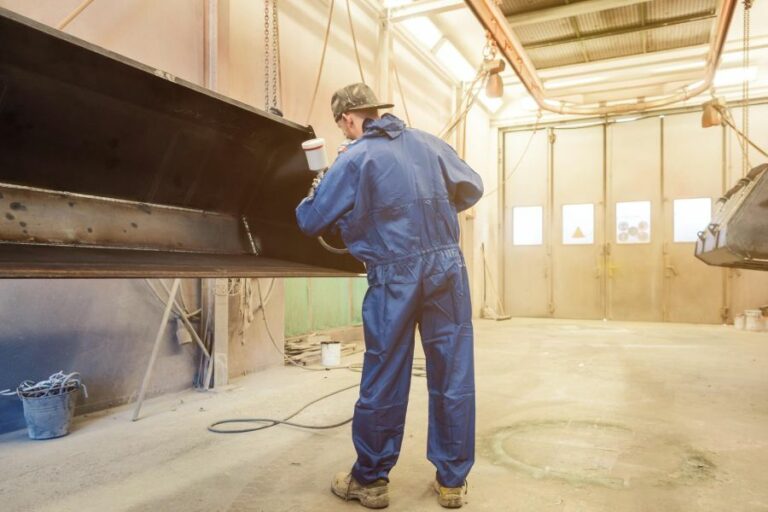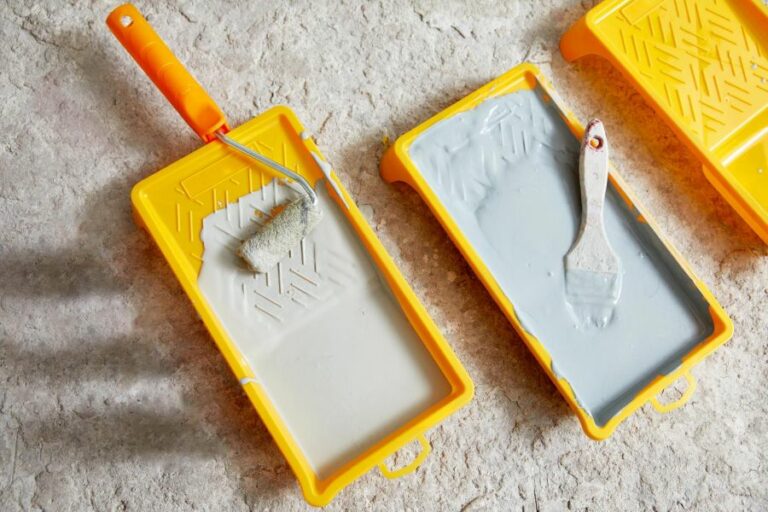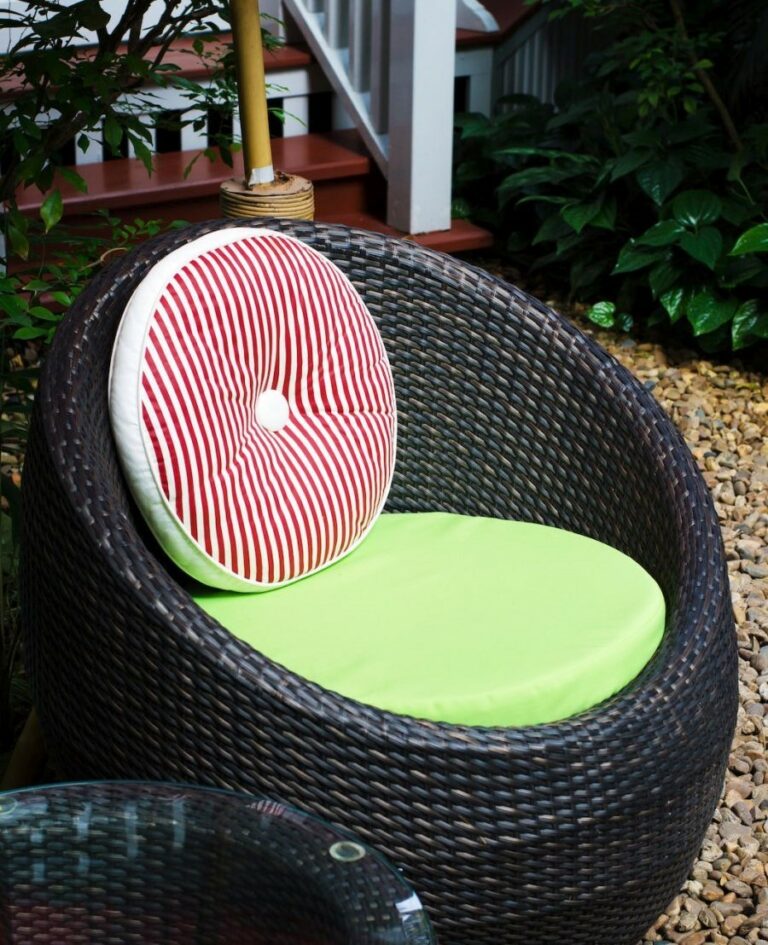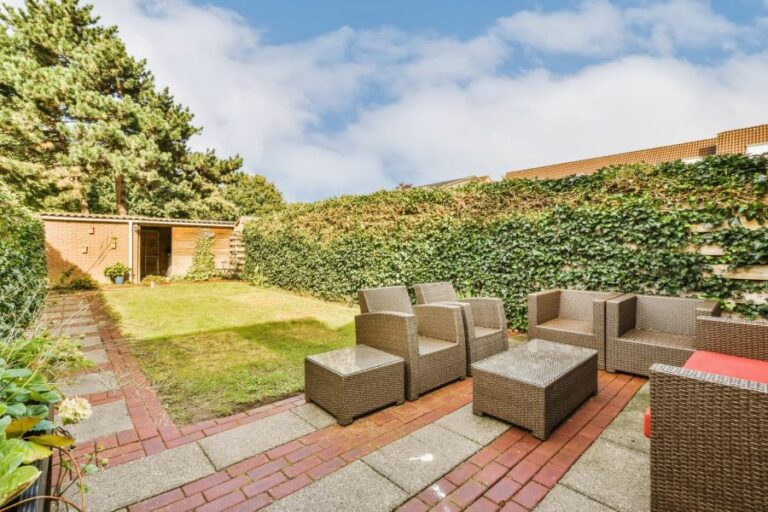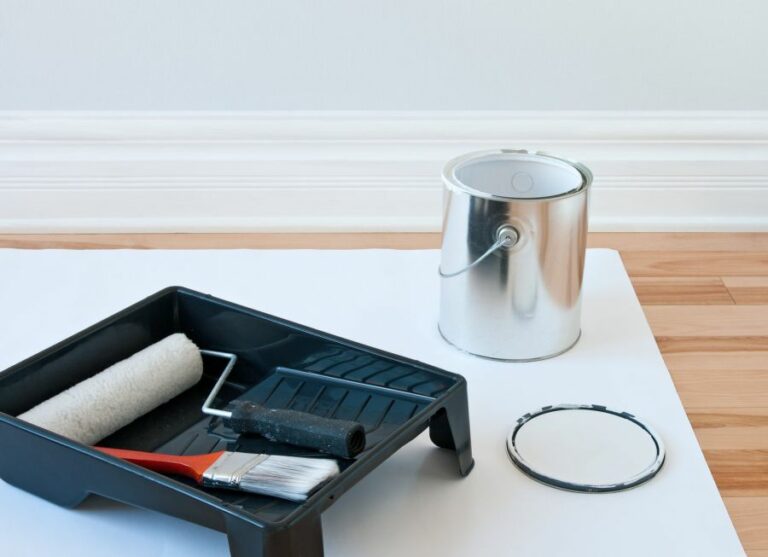How Long Does Outdoor Paint Take To Cure. What Pros Say
Are you planning to give your home’s exterior a fresh coat of paint? If so, knowing how long outdoor paint takes to cure is essential for a successful and lasting outcome. This post explores crucial factors influencing the curing process and provide a comprehensive guide on the ideal conditions and time frames for a perfectly painted surface.
How long does outdoor paint take to cure:
Exterior paint curing depends on factors such as weather, paint type, application method, and surface material. Temperature and humidity affect drying time, with solvent-based paints taking up to a week to cure, while water-based paints typically take a couple of days. Application technique and surface type also impact curing, with porous surfaces allowing faster evaporation. Optimal results require attentiveness, patience, and adherence to recommendations.

Discover crucial factors impacting your paint’s drying time, learn the difference between drying and curing, and familiarize yourself with ideal conditions and helpful tips to ensure your outdoor painting project reaches its full potential.
Contents
- 1 What is the Duration for Outdoor Paint to Fully Cure?
- 2 What is the duration required for exterior paint to cure fully?
- 3 What is the drying time for outdoor paint before it can withstand rainfall?
- 4 What are the methods to accelerate the curing process of exterior paint?
- 5 What is the drying time for exterior paint, depending on temperature?
- 6 What Occurs When Precipitation Ensues After a Paint Application?
What is the Duration for Outdoor Paint to Fully Cure?
Exterior paint has a crucial role in maintaining the aesthetics and durability of your property. To achieve optimum results, comprehending the paint’s curing process is vital.
• The Science of Curing: Polymerization and Coalescence
Understanding how the paint cures entail delving into the intricacies of its material composition. The curing mechanism is contingent upon the specific paint type and can be broadly delineated into two primary processes: polymerization and coalescence.
– Polymerization: A Dance of Molecules
Polymerization prevails within solvent-based paints, also known as oil-based or alkyd paints. The process involves drying through oxidation, where solvent molecules dissipate, enabling the solidification of paint particles as they bind together.
Thus, A resilient coating materializes, safeguarding your abode against the harsh elements.
– Coalescence: A Union of Latex Particles
Conversely, water-based or latex paint undergoes coalescence. Water molecules and additives evaporate, enabling the minute latex particles to fuse, forming a contiguous film. Latex paint is lauded for its eco-friendliness, ease of application, and rapid drying time.
• The Multifarious Factors Influencing Paint Curing Time
Numerous elements conspire in determining the time required for paint to completely cure. Delays in this phase might jeopardize the paint’s adherence and durability. We now navigate through these influential factors and their implications:
– Temperature and Humidity: Weathering the Weather
Ambient temperature and humidity levels possess a profound effect on the curing duration of your chosen paint. While solvent-based paints can withstand lower temperatures, water-based paints necessitate mild conditions, preferring temperatures between 50°F and 85°F.
Excessively low temperatures hinder the evaporation process and can deter paint from properly adhering to surfaces. High humidity levels make it arduous for water molecules to dissipate, prolonging the curing process.
– Paint Type: A Matter of Composition
As mentioned earlier, the type of paint you choose will distinctly affect the time required for proper curing. Alkyd-based paints call for extended periods, with some requiring up to a week for complete curing.
Meanwhile, latex paints have the propensity to dry and cure quickly, typically taking a couple of days.
– Layers and Application Technique: Depth and Distribution
The application technique and the number of paint layers applied significantly impact the curing process. A thicker coat of paint prolongs the curing time, as it impedes the evaporation of solvent or water molecules. A thinner application expedites the curing process.
Utilizing rollers or brushes generally permits a thinner, more evenly distributed application compared to the uneven layering that using a sprayer may produce.
– Surface Material: Substrate Specifics
Lastly, substrates onto which paint is applied also dictate the curing process. Porous surfaces, like wood or concrete, allow solvent or water molecules to permeate and evaporate more efficiently, while impervious materials like metal or plastic may elongate the curing time.
• Final Word: Patience Yields Perfection
Taking into account the myriad factors at play, it is facile to discern that there isn’t a “one size fits all” answer to ascertain the precise outdoor paint curing time.
As a general rule of thumb, allow a minimum of 24 hours for touch-dryness and a week for complete curing for solvent-based paints. The touch-dry phase spans four hours or less for water-based paints, while total curing takes a couple of days.
In both cases, consider optimal results contingent upon attentiveness, patience, and adherence to recommendations.
Devoting meticulous care and attention to the ever-important curing process will ensure that your investment in a fresh paint job is both enduring and visually enthralling.
Type of Paint | Drying Time | Curing Time |
|---|---|---|
Acrylic Latex | 2-4 hours | 2-4 weeks |
Oil-Based | 8-24 hours | 7-14 days |
Alkyd | 6-8 hours | 7-14 days |
What is the duration required for exterior paint to cure fully?
Exterior paint is an essential component of any home renovation or maintenance project. It not only enhances the appearance of your domicile but also safeguards it from inclement weather, making it crucial to understand the intricacies of paint curing times.
• A Symphony of Drying and Curing: What’s the Difference?
Before diving into the heart of the matter, it is fundamental to differentiate between two frequently conflated concepts: paint drying and paint curing.
- Drying: This initial phase transpires when the volatile solvents in paint evaporate, forming a solid, robust film. Despite feeling dry and sturdy to the touch, appearances may be deceiving; the paint remains vulnerable during this stage, as it is not yet completely impervious to external forces.
- Curing: The more protracted and subtle process, curing engenders a chemical reaction within the paint film. This interwoven network of molecules establishes a shielded barrier, conferring resilience to the elements.
• The Great Debate: Latex Paint vs. Oil-Based Paint Curing Times
1. Latex Paint: A Rapid and Expeditious Adversary
Permeating the lion’s share of home exteriors, latex paint’s burgeoning popularity hinges on its quick-drying attributes and long-lasting durability. Common curing times for latex paint are as follows:
- Drying to the touch: 1-2 hours
- Safe to recoat: 4-6 hours
- Complete cure: 14 – 30 days
Thwart the temptation to pass judgment on the surface’s readiness prematurely: patience is imperative for outstanding outcomes!
2. Oil-Based Paint: The Swaggering, Slow-Moving Sovereign
Championing flexibility and unrivaled adhesion to surfaces, oil-based paint may challenge the impetuous with its more gradual curing times:
- Drying to the touch: 6-8 hours
- Safe to recoat: 24 hours
- Complete cure: 21 – 60 days
A valiant virtue, temperance ensures triumph over precipitous pitfalls.
• The Dance of Variables: Conditions That Affect Paint Curing Times
A. Temperature’s Titillating Tango
A capricious and potent force, temperature exercises great power over paint curing rates. Be mindful of the Goldilocks Zone: the optimal range of 50 – 90°F (10 – 32°C) provides a seductive haven for prompt paint curing.
- Too Cold: Traversing below 50°F (10°C), temperature arrives at frigid depths that render paint sluggish, prolonging drying and curing times indefatigably.
- Too Hot: Ascending above 90°F (32°C), scorching heat induces mischievous frolicking, accelerating evaporation and causing the paint to crack or blister.
B. Humidity’s Hypnotic Waltz
A sultry symphony of sweltering air and humidity bewitches exterior paint drying and curing processes. Aim for moisture content of 40 – 70% during your painting odyssey.
- Too Dry: Despotic desiccation creates a parched panorama, inflicting brittle curses upon the paint, which crack and peel resentfully.
- Too Damp: Excessive moisture plays a dampened dirge, extending drying times and predisposing the painted surface to an array of maladies, including mildew, streaking, or sagging.
C. Coat Thickness: The Layered Polka of Portliness
In an exuberant dalliance with the brush, balance emerges as the keystone: svelte, slender coats expedite the curing process whilst ensuring an impeccable finish, radiating resplendent beauty.
• In Conclusion: The Finale of Determination
Despite the inherent vicissitudes that accompany exterior painting endeavors, understanding the artistry and science behind paint curing times empowers you to orchestrate successful outcomes for your home’s facade.
By remaining vigilant and adapting to conditions such as temperature, humidity, and coat thickness, you can harmonize the elements to achieve stunning masterpieces, resplendent with durability and artistic allure. Happy painting!
Type of Paint | Minimum Dry Time | Full Cure Time |
|---|---|---|
Acrylic Latex | 1 – 2 hours | 3 – 4 weeks |
Oil-based | 6 – 8 hours | 6 – 8 weeks |
Alkyd | 2 – 4 hours | 4 – 6 weeks |
Urethane | 2 – 4 hours | 4 – 6 weeks |
What is the drying time for outdoor paint before it can withstand rainfall?
• Factors Determining the Drying Time for Exterior Paint
– The Humidity Quotient
Environmental moisture can radically influence the paint’s drying trajectory regardless of the substrate being painted. Humidity is a vital factor that cannot be overlooked.
Swing your attention to your local weather forecast and scout for days characterized by low humidity levels, as these provide a conducive environment for an unblemished paint job.
– Temperature and Meridian Movements
The sun’s eternal dance across the sky bears a colossal impact on paint drying times. If you wish to harness the full spectrum of solar energy, initiate painting activities early in the day, allowing ample opportunity for the paint to dry in the sun’s radiant warmth.
Aim for temperatures between 50 to 85 degrees Fahrenheit; these are the optimal conditions for exterior paint to achieve an expedited drying time.
– Paint Composition: A Labyrinth of Coagulating Components
In general, you’ll encounter two primary types of exterior paint:
- Water-Based (Latex/Acrylic)
- Oil-Based (Alkyd)
Water-Based Paints: Fast-Track to Aqueous Absolution
Water-based paints, both latex, and acrylic, are known for their expeditious drying capabilities. Expedience is achieved owing to the accelerated evaporation of water molecules within the paint.
Once applied, water-based paints typically demand no more than 1 to 2 hours of clemency from the elements. Any incoming rainstorms must be deferred until this time has elapsed to minimize your work’s vulnerability to water’s destructive force.
Oil-Based Paints: Elusive Eons of Coagulation
Alkyd components present in oil-based paints render the drying process a more lethargic affair. Whereas water-based paints leverage evaporation, oil-based paints rely on oxidation, which entails a lengthier drying process.
Incessantly tapping your foot as you wait for the monotonous passage of time? Look toward the duration of 6 to 8 hours before oil-based paint acquires immunity against rain’s relentless torrent.
• The Symphony of Paint and Rain: A Consequence of Unrequited Timing
If pelting precipitation reaches the barricades before your paint has garnered ample drying time, you may lamentably stumble upon the following maladies:
– Discoloration: Rain’s Bane on the Spectrum of Shades
Rainfall can potentially seep into the paint layer and alter its chemical composition, thereby transmogrifying the intended hue into a dissonant visual cacophony. Your once vibrant symphony of shades will devolve into a discolored dirge of mismatched tones.
– Bubbling and Peeling: Unraveling the Tapestry of Textures
A premature deluge can wreak havoc on the consistency of the paint job. When rain infiltrates uncured paint, it instigates bubbling, blistering, and eventually peeling. The resultant texture of the painted surface will bear the unfortunate semblance of a topographical mishap.
To rectify this situation, you must sand and repaint the impacted areas.
• Jettisoning Towards Conclusion: Deluges and Drying Times
How long must one wait for their paint to dry sufficiently to withstand rain’s impending ambush? For swift-drying water-based paint, offer nothing less than a 1-to-2-hour buffer period. In the case of slow-coagulating oil-based paint, maintain a cautious vigil for a 6-to-8-hour spell.
With these timeframes in mind, calibrate your painting activities to coincide with atmospheric conditions that promote optimal drying and paint with the unbridled enthusiasm of a master craftsman.
Type of Paint | Minimum Drying Time |
|---|---|
Acrylic Latex Paint | 1-2 hours |
Oil-Based Paint | 24 hours |
Quick-Dry Paint | 30 minutes to 1 hour |
Heavier Application | Confirm with product directions |
High Humidity or Low Temperature | Longer drying time required (follow product specifications) |
What are the methods to accelerate the curing process of exterior paint?
A rapid paint-curing process can leave your home looking pristine and polished in no time.
• Crucial Considerations for Expediting the Paint-Curing Voyage
– Favored Climate Conditions: Harness the Power of the Elements
Mother Nature can either aid or thwart your efforts to accelerate the paint-curing process. Evade unfavorable conditions and dauntless winds while embracing the sun’s nurturing warmth.
- Optimal temperature: Endeavor to paint when the ambient temperature ranges between 50°F and 90°F (10°C and 32°C), which facilitates timely drying.
- Humidity considerations: A relative humidity below 80% is propitious for swift curing. Elevated humidity may cause undue delays.
- Wind patterns: Foster paint curing by selecting days with gentle zephyrs. Excessively blustery days will compel paint to adhere unevenly.
– Type of Paint: Thoughtful Selection of the Perfect Blend
Much like a sommelier chooses the perfect vintage, understanding the variations between paint varieties will enable you to select the ideal blend to ensure accelerated curing.
- Latex paints: These water-based concoctions ensure a faster cure time compared to their oil-based counterparts. Due to their quick-drying properties, latex paints are generally preferred.
- Oil-based paints: While remitting remarkable durability, oil-based paints are notorious for their slow-drying pace, which may not be conducive to a swift exterior transformation.
– The Mythical Efficacy of Paint Additives
Numerous paint additives claim to hasten the paint’s drying time. However, these products may lurk in an area of ambiguity. Do they truly deliver the results they promise?
- Alkyd resin: Alkyd resin can be incorporated into oil-based paints to expedite drying. However, proceed cautiously, as excessive alkyd can compromise the paint’s finish and longevity.
- Latex paint accelerators: Accelerators are formulated to facilitate swift drying in water-based paints. These additives are known for their dubious efficacy; diligent research is advised before usage.
• Polished Techniques for Paint Application
– Brushing and Rolling: A Synchronous Dance with Nuanced Steps
Apply the paint dexterously and with finesse as an artist creates a masterpiece.
- Beware of overapplying: Apply paint in moderately thin layers; thick layers prolong drying time and may result in a marred exterior finish.
- Relish uniformity: Empower your brush and roller movements to exhibit grace and symmetry, ensuring a smooth, even application of paint that aids rapid curing.
– Utilizing Sprayers: The Hidden Virtues of Machines
Sprayers are favored for their ability to apply paint uniformly, which ultimately accelerates the curing process. However, thorough preparation is key for utilizing these devices.
- Preventing overspray: Shield neighboring surfaces and objects from inadvertently receiving paint. Meticulous masking will protect these vicinal entities.
- Produce a harmonious setting: Tend to the sprayer’s pressure and nozzle settings to safeguard an impeccably balanced paint application, as this will promote expeditious curing.
• Enlightenment for the Anticipation Phase
While endeavoring to expedite the paint-curing process is laudable, bestowing patience upon this project is also essential.
- Inspect the paint can: Peruse the manufacturer’s guidelines for drying times, and allow these recommendations to instill you with serene confidence.
- The power of touch: Validation of the paint’s dryness can be ascertained by delicately grazing the surface without leaving fingerprints or disrupting the supple protective layer.
In summation, accelerating the exterior paint-curing process may be cultivated by attending to climate conditions, selecting the ideal paint, and refining application techniques.
While desiring to hasten this undertaking is understandable, appreciating the artistry that comes with a well-executed paint job will reward you with a stunningly transformed exterior, which will be admired by all who pass by.
What is the drying time for exterior paint, depending on temperature?
Unbeknownst to many, the relationship between temperature and exterior paint drying times constitutes an intricate dance that warrants diligent observance. Not only does it affect the paint’s final appearance, but it also plays a pivotal role in ensuring the longevity and quality of the paint job.
Thus, understanding this delicate art of temperature’s influence on exterior paint is indispensable for a successful painting project.
• The Calibrated Quest: Discerning the Ideal Temperature Range
Naturally, the question arises: What constitutes the optimal temperature range for exterior paint to dry efficiently?
To answer this, one must first comprehend that paint manufacturers have meticulously calibrated particular temperature ranges, typically falling between 50°F and 90°F, for their products to perform exceptionally.
These temperature bands ensure that application, drying, and curing processes transpire smoothly, ultimately yielding admirable results.
– Cool Climates and the Cautious Brush
Diverging from the recommended temperature range can be a precarious venture. Delving into cooler temperatures of less than 50°F may instigate a lethargic pace in drying, at times yielding distressing results.
Consequently, the paint is prone to be tainted, developing an undesirable tackiness and remaining vulnerable to damage for extended durations.
Anecdote of Frosty Encounters: The Imperative to Sidestep Freezing Conditions
An essential caveat when navigating cool climates is assiduously steering clear of freezing temperatures. The encroachment of frost during the drying process can wreak irreparable havoc on your painting endeavors.
The cryptic treachery of low temperatures results in the disintegration of the paint’s integrity and, ultimately, its premature failure.
– Rising Temperatures and the Vigilant Stroke
Turning our attention to soaring temperatures above 90F, one is faced with a contrasting set of challenges.
These sultry conditions exude an air of expedited drying, often deemed excessively swift. Consequently, the paint fails to adhere adequately to the surface, making it susceptible to issues such as peeling or blistering over time.
Venturing further into scalding temperatures accelerates chalking, encouraging the gradual deterioration of the paint’s surface quality.
• Humidity’s Enigmatic Waltz: A Factor to Reckon With
While discerning the ideal temperature range is of paramount importance, one cannot overlook the enigmatic waltz enacted by humidity within the realm of exterior paint drying.
Unequivocally, the volitional interplay of humidity and temperature profoundly influences drying times and the final outcome of your painting endeavors.
– The Compelling Saga of Evaporation and Coalescence: The Mortal Combat against Moisture
To fathom the influence of humidity, we must delve into the depths of the drying process. Two pivotal stages in this process are evaporation, where water and solvent molecules escape from the paint film and coalescence, the subsequent fusing of remaining resin particles.
Excessively moist conditions decelerate evaporation and simultaneously impair coalescence, yielding an enfeebled paint film with compromised durability.
– Atmosphere of Saturation: The Scourge of High Humidity
When confronted with high humidity levels above 70%, paint requires extended durations to dry and cure. This atmosphere of saturation contends against the drying process’ progression, prolonging the paint’s vulnerability to damage and imperfections.
Prolonged exposure to these undesirable conditions may inflict long-lasting consequences on the paint job’s overall quality.
• Calculating the Equation: Factors Affecting Drying and Curing Times
Although temperature and humidity stand as two preeminent factors impacting exterior paint drying, other variables also come into play. Conditions such as the type of paint, its thickness, surface material, and exposure to sunlight may affect the duration it takes for the paint to dry and cure.
It is crucial to meticulously account for these elements when anticipating an accurate timeline for your painting project.
• In Conclusion: The Mastery of Patience and Prudence
Mastering the intricate dance of temperature and exterior paint drying necessitates a keen awareness of these nuances to achieve outstanding results. By observing fastidious patience and prudence, one can adeptly manipulate these conditions and safeguard the integrity and lifespan of your exterior paint job.
Temperature Range | Approximate Drying Time |
|---|---|
35°F – 50°F (1°C – 10°C) | 6 – 8 hours |
50°F – 70°F (10°C – 21°C) | 4 – 6 hours |
70°F – 90°F (21°C – 32°C) | 2 – 4 hours |
90°F + (32°C +) | 1 – 2 hours |
What Occurs When Precipitation Ensues After a Paint Application?
• The Meteorological Menace: Rain
Picture the scene: you’ve meticulously coordinated the hues, procured the choicest pigments, and proficiently applied multiple coats upon your edifice or domicile. But, despite your earnest preparations and consummate craftsmanship, fate decrees an impending downpour.
Is your fete of freshly applied pigmentations doomed? Read on to learn the consequences if the skies unleash and rain befalls your resplendent work after painting!
• Underpinnings of Paint: The Crucial Curing Process
Before diving into the hydrological implications of your bountiful brushstrokes, it’s essential to grasp the cardinal aspect of the painting process: curing.
When coatings and stains adhere to a surface, they undergo a process of oxidation, during which the solvents evaporate, paving the way for chemical bonding and solidification. Curing paves the path for a lustrous, adamantine finish that can defy the touch of time and capriciously cast climatic challenges.
– Latex Deluge: Water-Based Paint and Rain
Water-based paints, colloquially referred to as latex paints, boast an eminently simple chemical composition, a plethora of pigments and resins suspended in a watery solution. These paints are beloved for their quick drying times and ease of use.
Yet, when confronted with untimely showers or encroaching dampness, a tenuous interplay can ensue.
A temporary downpour in the midst of the curing process may dilute the paint, causing blistering or peeling. These hydrological assailants may also induce color fading or an unanticipated alteration in hue.
However, should the rain conclude promptly and providence bequeaths sunlight, the remnants of the ordeal may be decidedly less detrimental.
– The Oily Predicament: Oil-Based Paint and Rain
When oil-based paints grace surfaces, they bring forth a glistening visage uniquely derived from their blend of linseed oil, solvents, and pigments. Although the appeal of oil-based paints is undeniable, the tenacity of these applications is inextricably bound to appropriate drying and curing conditions.
Enter the malevolent torrents of precipitation, and complications may come to the fore.
The extended drying time of oil-based paints demands an interval free from precipitation, as exposure to moisture during the crucial stages of curing can occasion a host of travail.
The outcome may range from splotchy areas of inconsistent gloss all the way to paint films that never truly solidify, resulting in a perpetually tacky surface.
• Engaging in Rain-Proof Enlightenment: Effective Strategies
Given science’s inexorable march, modern paint formulations have made strides in bypassing these meteorological melees. However, caution and care are indispensable-lest one’s painting endeavors be dashed by the elements. Consider these sagacious stratagems:
- Scrutinize Weather Forecasts: A keen eye on local weather predictions might protect your efforts from ruinous storm clouds.
- Time Applications Incisively: Morning or early afternoon is optimal for painting to dodge the sorrows of evening humidity or pre-dawn dew.
- Embrace Proper Ventilation: Encourage faster drying and evaporative success with regulated interior air circulation.
- Endeavor to Shield: Erect temporary barriers or coverings to safeguard exterior projects from nature’s unpredictable ravages.
• Redemption and Rectification: Post-Rain Paint Recovery
Should the caprices of the heavens besmirch your day of painting, fear not, for the reclamation of your artisanal endeavor is within reach. Summon the mastery of sandpaper, primer, and patience, and then reapply the paint with the perseverance of a master craftsman.
Through trial and tribulation, the aesthetic potential of surfaces untouched by precipitation may yet be achieved!
Consequence | Description |
|---|---|
Water Spots | Rain can cause water spots on the painted surface, leaving behind uneven marks. |
Discoloration | Rainwater can cause certain sections of the paint to change color, possibly due to dilution of the paint. |
Peeling or Bubbling Paint | Rain can lead to moisture seeping under the paint layer, causing it to peel or bubble over time. |
Damage to Primer or Underlying Materials | Rain can affect the primer and underlying materials, potentially causing long-term damage and reducing the lifespan of the paint job. |
Longer Drying Times | Rainy conditions often increase the humidity in the air, which can lead to longer drying times for the paint. |


